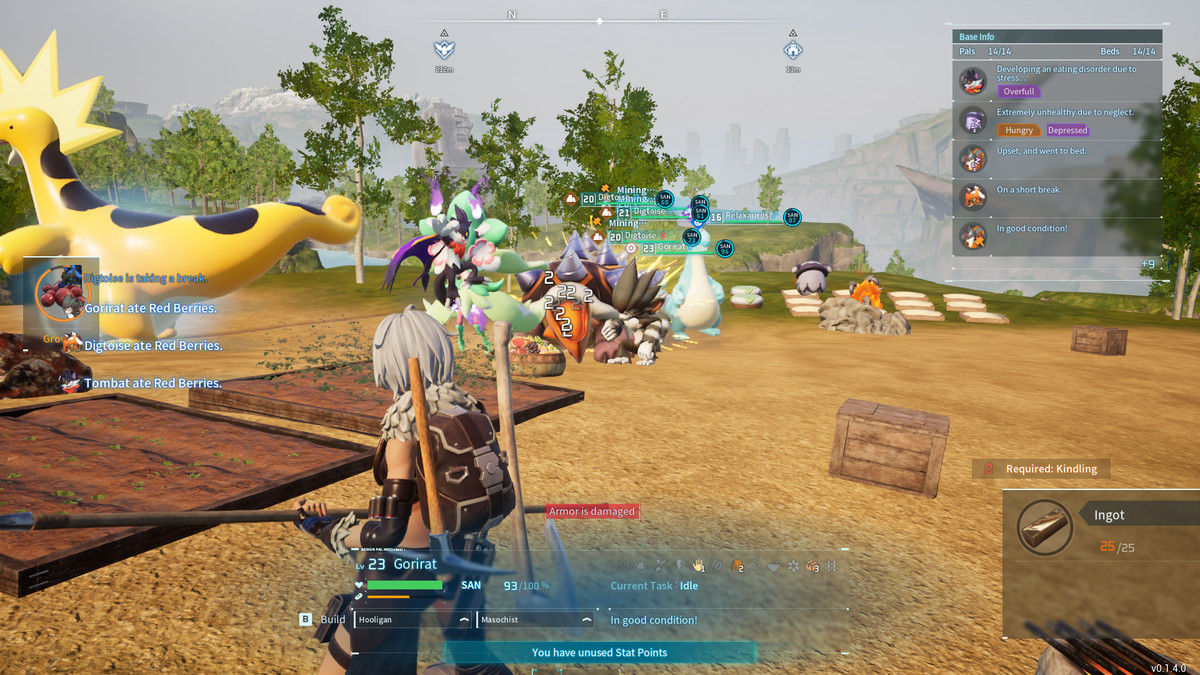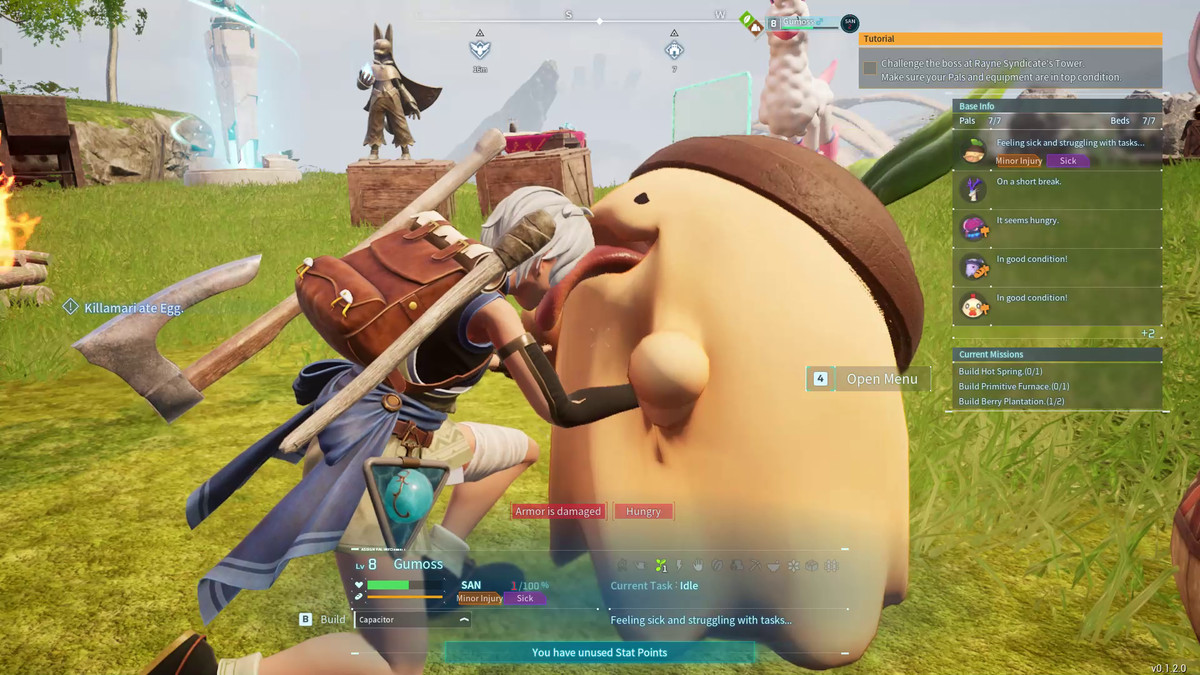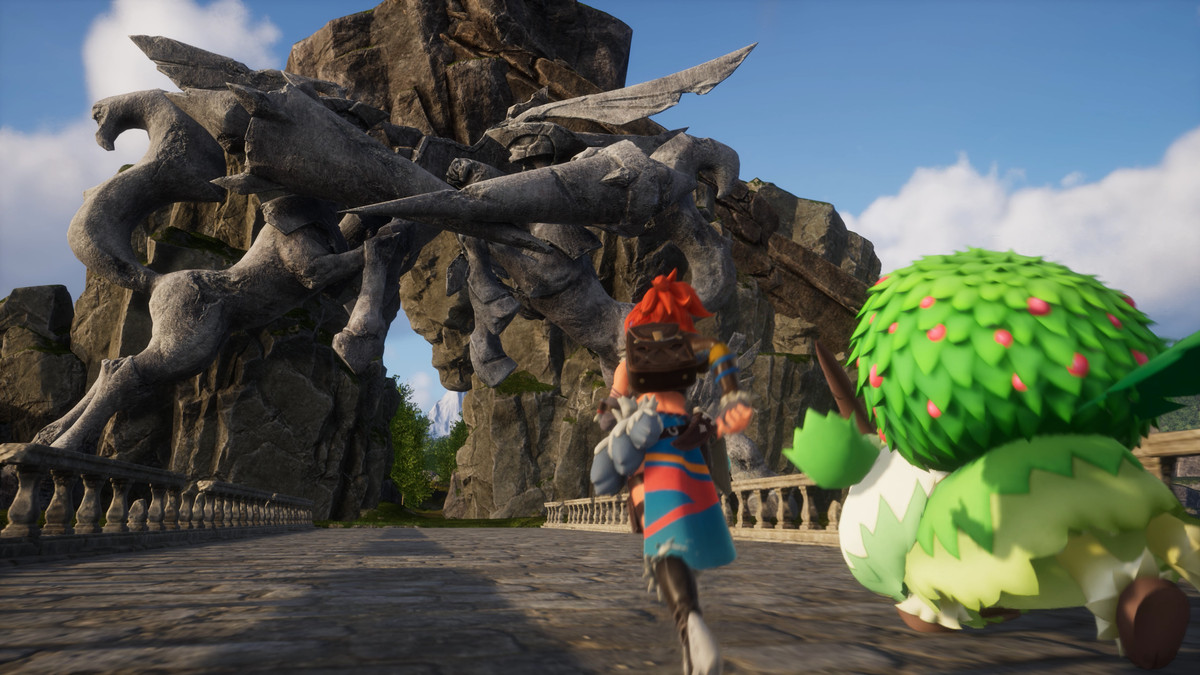Palworld is the pinnacle of every game I’ve ever loved
Palworld unfolds like a fever dream of so many games I’ve played and loved.
I charged into the vast world riding on the back of a mythical deer, capturing cartoonish creatures as if it were a Pokémon game. These battles with the creatures sometimes feel frantic; the combat itself plays like a first-person shooter where I shoot monsters and dodge their attacks by rolling around like I would in a Soulslike game. After catching creatures like, say, a giant dinosaur that looks like a rubber toy, I realize that my character needs to eat, just like I would in Minecraft. Luckily for me, the food I collected and cooked at my base hasn’t expired yet. I turn it down and I’m ready to go, so I jog across a patch of wooded forest to get to a new waypoint of the vast natural world – just as I would in The Legend of Zelda: Breath of the Wild.
For some people, Palworld is perhaps a bit too much and overwhelming, as it brings together elements from so many different games and genres. The fact that the game even functions at a basic level feels like a miracle – a sentiment shared by the CEO of Pocketpair, the Japanese indie studio that Palworldwho described the making of Palworld as a ‘miracle’. But as someone whose gaming tastes are largely shaped by series like Pokémon, FortniteThe Legend of Zelda, and Minecraftthe tricky mix of Palworld it feels like it was tailor-made for me.
Palworld begins with a tutorial that functions as an extensive to-do list that guides players to the first boss fight. Slowly but surely, I worked my way up from picking up objects from the ground to crafting items and harvesting materials, and then automating various resource gathering processes by constantly upgrading my bases and using my Pokémon-like Pal -putting beings to work. As I play, I alternate between managing my base and capturing friends as I explore the game’s overworld.
Image: Bag pair
While forcing my friends to work is an unavoidable part of the game, the way I capture them and play with the friends in the game doesn’t feel as dark or transgressive – at least not in the way the ads in the game game insinuated. Sure, I can fire the cute penguin-like friend Pengullet from a rocket launcher and it will explode like a bomb, but the cartoonish nature of the game leans more toward absurdity than brutality. Palworld isn’t explicit and it doesn’t seem to encourage the abuse of friends that much because I need them to work. I found the way the systems explicitly emphasize the inherently exploitative relationship between the creatures and the player character to be refreshing, even if the game’s writing offers no specific commentary on that relationship.
I released a Relaxaurus, the big dumb rubber dino I caught earlier, onto my base for the first time and just screamed when I saw it completely dwarfing all the Pals and staring blankly at them with a look that screamed, ” I have exactly two brain cells and I use them both to water your damn berries. Then there’s Depresso, a grumpy cat who needs constant chemical motivation, delivered by pressing F to give him a “caffeine shot.” It’s so good that I ended up keeping one in my company for the entire game, despite its relative lack of usability. Small details – like the hug animation where my character sticks his entire head into a slime monster’s wide mouth – have endeared the game’s many adorable creatures even more to me.

These Pals also play a central role in the progression of the game. Palworld rewards players with extra experience points for catching the first 10 copies of a certain type of Pal, which prompted me to catch as many Pals as possible. For context, crafting items might only get you six experience points, while taking a while to catch a weak Level 4 Lamball could net you over 500 experience points. Leveling up my character is a hugely important aspect of the game, as it allows me to upgrade stats such as stamina, attack or health. And unlock the schematics to create essential technology for my basic and crafting recipes. For example, you need to be level 26 to unlock a generator, which is a requirement to level up the base.
Since I have to catch a lot of Pals to level up my character, progress feels largely dependent on the number of Pals I can catch, which in turn depends on the number and variety of Pal spheres I can create to get them to catch. In this way, Palworld‘s progression system has a domino effect where I need certain types of ores to create Pal spheres, which in turn requires me to set up mines at my base or a higher level so I can build a second base to make a specific ore to mine, which then requires specific technology to keep Pals happy and working. Once I’ve made the right orbs, I can start exploring the region and catch as many friends as possible.

The result is that there is progress Palworld is not that flexible. Sometimes I wanted to concentrate on it just now explore or only Catching friends, but those actions wouldn’t improve my character or give me the resources I needed. So to continue my progress, I really had to focus on creating atmospheres and then on upgrades that supported my player character as he explored regions with new Friends so that I could in turn gain more experience points. While it can feel restrictive if someone wants to delve into a specific element of the game, this progression system also gives a potentially unwieldy game an overall sense of structure, even though it contains so many different forms of gameplay.
In the early days after launch, there were many players who said something about it Palworld due to the perceived lack of originality. The game clearly takes influences from several games I mentioned in the introduction. But Palworld doesn’t just ‘steal’ game concepts in a way that comes across as pure copy-pasting. Instead, it’s more like the developers took aspects of so many of the games I grew up with and put them into a revolving door of varied gameplay, resulting in a cohesive loop.
Better yet, the elements of Palworld which are clearly inspired by other games, allowed me to approach the game’s multiplayer with a shared language. While playing co-op with my brother, before learning the Pals’ real names, we would sometimes call them by the name of their Pokémon lookalike. One time I even started screaming when my brother desperately yelled at me to “rescue” him because a friend had knocked him out, as if we were running around in a Fortnite agreement.
This game tries to do a lot and therefore has some rough edges. Don’t expect the polish and thoroughness in design that would be present in a big budget AAA game. It doesn’t have the fanciest soundtrack, and while the overworld map is absolutely massive – I can explore volcanic and snow biomes and everything in between – the environments don’t exactly feel imbued with a sense of wonder or mystery. The game is still in early access and contains many bugs. The Pals can easily get stuck while walking around a base, and sometimes my character gets stuck in certain animations or lags when I try to jump while climbing, for example.
Playing over the course of my time PalworldI did not experience a perfectly balanced and smooth slope from start to finish. The transition from making regular old Pal orbs to making the Mega and Giga orbs felt a bit rough and grindy. At some point the standard Pal spheres become completely useless because the catch rates are so low, and creating the next level of Pal spheres took some puzzling; I had to come up with a solid camp location and capture the right friends to set up the infrastructure to mine enough ore to make blocks for the orbs.

Image: Bag pair
Still, I enjoyed my time with Palworld. There was just enough structure and variety between working on my base, exploring and catching friends, and I enjoyed the fact that it all worked. It’s a game that has made me rethink what types of games and genres can and will fit together. Sometimes the game collapsed under its enormous scope; certain systems glitch or play as if they are a work in progress. Yet this Frankenstein monster of a video game contains a survival adventure that is both tough and surprisingly joyful. It’s only in early access, but I can’t wait to see what the future has in store Palworld.
